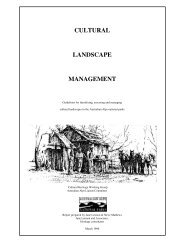Aboriginal People and the Australian Alps (pdf)
Aboriginal People and the Australian Alps (pdf)
Aboriginal People and the Australian Alps (pdf)
Create successful ePaper yourself
Turn your PDF publications into a flip-book with our unique Google optimized e-Paper software.
aboriginalpeopleworkingtoge<strong>the</strong>r<strong>Aboriginal</strong> sites <strong>and</strong> objects in <strong>the</strong> <strong>Alps</strong> are valued by all <strong>and</strong> are protected by legislation bystate <strong>and</strong> federal legislation. It is illegal to disturb, damage or destroy an object or <strong>Aboriginal</strong>place without consent from <strong>the</strong> relevant authority. However, <strong>Aboriginal</strong> culture is greater thanjust <strong>the</strong>se physical sites.Entire l<strong>and</strong>scapes also hold significant cultural values. From an <strong>Aboriginal</strong> perspective l<strong>and</strong> <strong>and</strong> peopleare inseparable. The mountains provided <strong>Aboriginal</strong> people with food, shelter, clothing, tools, utensils <strong>and</strong>medicine. Beyond this <strong>the</strong> messages underlying <strong>the</strong> stories of ancestral beings, who shaped <strong>the</strong> plant <strong>and</strong>animal communities <strong>and</strong> <strong>the</strong> l<strong>and</strong>scapes <strong>the</strong>mselves, governed all aspects of traditional <strong>Aboriginal</strong> society.These story lines link people <strong>and</strong> features of <strong>the</strong> mountains with those of o<strong>the</strong>r distant places to this day.Kosciuszko National Park, 2006, p. 83<strong>Aboriginal</strong> people have used <strong>the</strong>ir traditional laws, knowledge <strong>and</strong> skills to manage <strong>the</strong> <strong>Australian</strong><strong>Alps</strong> for thous<strong>and</strong>s of years <strong>and</strong> this management has influenced alpine ecosystems.National park agencies in <strong>the</strong> <strong>Australian</strong> <strong>Alps</strong> are working with <strong>Aboriginal</strong> people with traditionalconnections with <strong>the</strong> <strong>Alps</strong> to manage not only <strong>the</strong> physical sites but also intangiblevalues. <strong>Aboriginal</strong> culture is a living culture <strong>and</strong> to maintain this culture <strong>Aboriginal</strong> people needaccess to l<strong>and</strong> <strong>and</strong> natural resources so that <strong>the</strong>y can practice <strong>and</strong> pass on <strong>the</strong>ir traditionalknowledge <strong>and</strong> skills. They also have strong feelings of attachment to <strong>the</strong>ir traditional l<strong>and</strong><strong>and</strong> are keen to work closely with l<strong>and</strong> managers so that <strong>the</strong>y can be involved in decisionmaking concerning <strong>the</strong>ir heritage – <strong>the</strong>ir Country.To support this, <strong>the</strong> <strong>Australian</strong> <strong>Alps</strong> National Parks sponsored a ga<strong>the</strong>ring of <strong>Aboriginal</strong> traditionalowners, that is, <strong>Aboriginal</strong> people with traditional connections to <strong>the</strong> <strong>Alps</strong>, at DinnerPlain in 2005. Dinner Plain was one of <strong>the</strong> places where <strong>Aboriginal</strong> people ga<strong>the</strong>red for talksin <strong>the</strong> days before European settlement.At this meeting <strong>the</strong> traditional owners present, proposed that <strong>the</strong> <strong>Australian</strong> <strong>Alps</strong> First <strong>People</strong>sdevelop an agreement amongst <strong>the</strong>mselves so that <strong>the</strong>y can establish ways for this group towork more effectively toge<strong>the</strong>r as one group.Some of <strong>the</strong>ir o<strong>the</strong>r recommendations included:• recognition from l<strong>and</strong> management agencies that Traditional Owners are <strong>the</strong> only legitimateIndigenous speakers for Country;• identification of area of crown l<strong>and</strong> in <strong>the</strong> <strong>Alps</strong> as an area for traditional ownersto meet <strong>and</strong> continue traditions, practices <strong>and</strong> customs;• establishment of an <strong>Australian</strong> <strong>Alps</strong> First <strong>People</strong>s Keeping Place;• access for Traditional Owners to cultural resources, for example, fishing, hunting, collecting<strong>and</strong> ga<strong>the</strong>ring rights without a license;• provision by l<strong>and</strong> management agencies for adequate financial resources to ensure equityof involvement of traditional owners in all aspects <strong>and</strong> levels of l<strong>and</strong> <strong>and</strong> waterways management;<strong>and</strong>• increased employment opportunities for traditional owners through <strong>the</strong> support of l<strong>and</strong>management agencies.EDUCATION RESOURCE ABORIGINAL PEOPLE 4/5
















